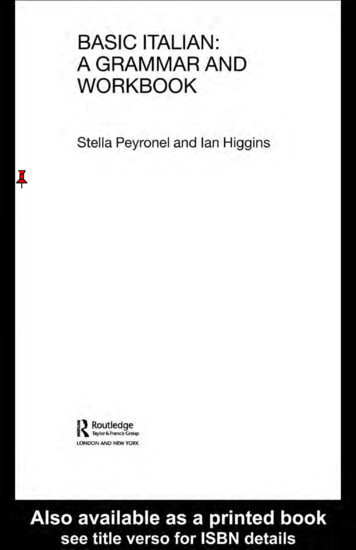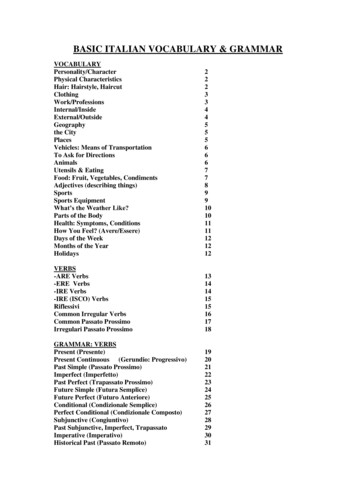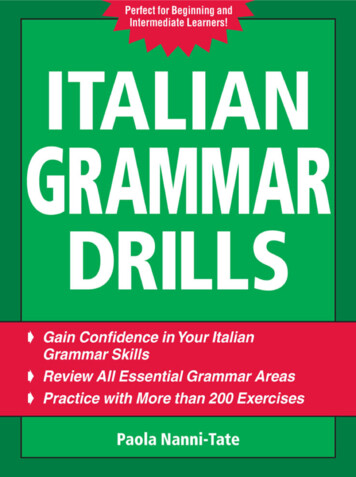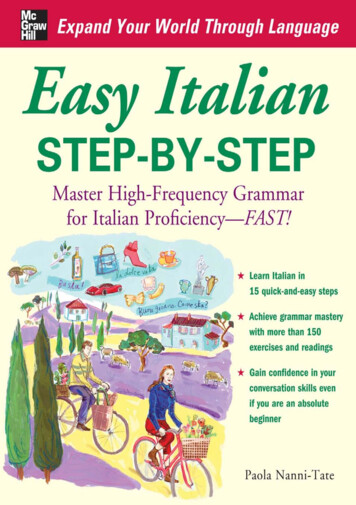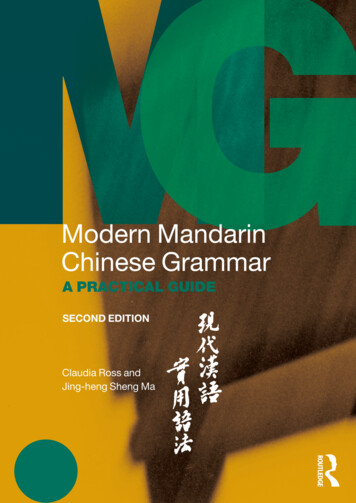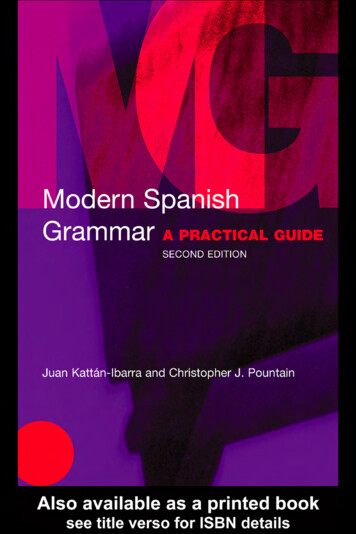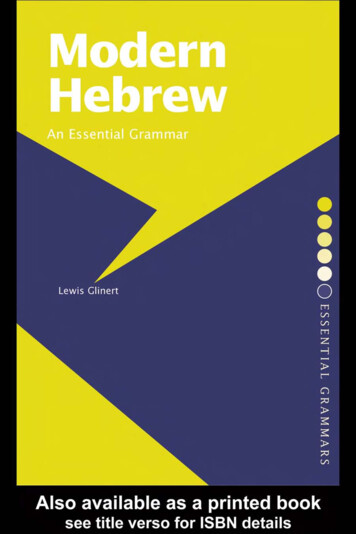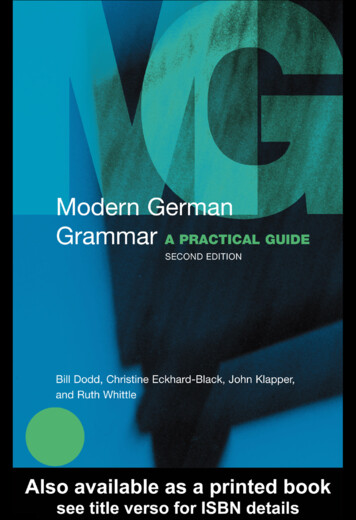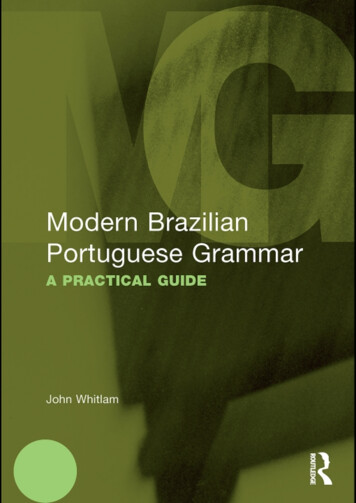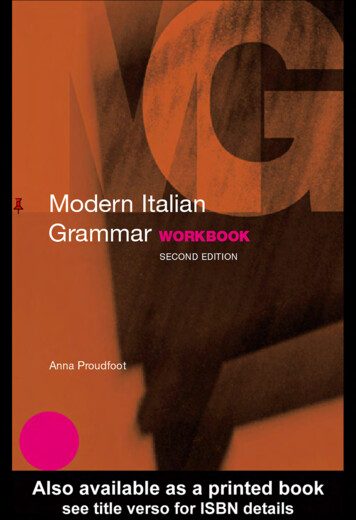
Transcription
ModernITALIANGrammarWORKBOOKSecond Edition
Routledge Modern GrammarsSeries concept and development – Sarah ButlerOther books in the series:Modern Italian Grammar, Second Edition by Anna Proudfoot and Francesco CardoISBN: HB 0–415–33483–7; PB 0–415–33164–1Modern French Grammar, Second EditionModern French Grammar Workbook, Second EditionModern German Grammar, Second EditionModern German Grammar Workbook, Second EditionModern Spanish Grammar, Second EditionModern Spanish Grammar Workbook, Second Edition
ModernITALIANGrammarWORKBOOKSecond EditionAnna Proudfoot
First published 1999by RoutledgeSecond edition published 2005by Routledge2 Park Square, Milton Park, Abingdon, Oxon OX14 4RNSimultaneously published in the USA and Canadaby Routledge270 Madison Ave, New York, NY 10016Routledge is an imprint of the Taylor & Francis GroupThis edition published in the Taylor & Francis e-Library, 2005.“To purchase your own copy of this or any of Taylor & Francis or Routledge’scollection of thousands of eBooks please go to www.eBookstore.tandf.co.uk.” 1999, 2005 Anna ProudfootAll rights reserved. No part of this book may be reprinted orreproduced or utilised in any form or by any electronic,mechanical or other means, now known or hereafterinvented, including photocopying and recording, or in anyinformation storage or retrieval system, without permission inwriting from the publishers.British Library Cataloguing in Publication DataA catalogue record for this book is available from the British LibraryLibrary of Congress Cataloging in Publication DataA catalog record is not needed for this title as it is expendable educational materialISBN 0-203-39728-2 Master e-book ISBNISBN 0-203-67134-1 (Adobe eReader Format)ISBN 0–415–33165–X (Print Edition)
ContentsIntroductionHow to use this bookSection 1 Structures1INouns, articles and adjectives3IIVerbs14III Pronouns30IV Prepositions41V43ConjunctionsVI Adverbs44VII Times, dates, weights and measures45Section 2 Functions49Section 3 Scenarios85IArranging to do a summer language course in Italy 87IIApplying for a summer job90III The work placement in Italy93IV Romance in the workplace96Answer keyTerminologiaCross-references to Modern Italian GrammarIndexvviiix99136139144
IntroductionModern Italian Grammar Workbook was designed as the companion volumeto the Routledge Modern Italian Grammar (MIG), but can also be used onits own or as back-up to other courses or grammar texts. The new revisededition of this workbook has extensive cross-references to MIG at thebeginning of each exercise to make it easier to check or practise languagepoints. Since all instructions are in English, and clear examples are givenwith most exercises, it can be used either by students on their own or inclass with a teacher. There is an Answer key at the end of the book, whichwill allow you to check your answers as you go. Modern Italian GrammarWorkbook is designed to suit learners at all levels from near-beginner to thefinal year of a degree course.The coursebooks and textbooks published over the last two decades arebased on the principles of the communicative approach to language learning,which recognises that the objective of any language learner is to communicate,to get one’s message across, and that there can be many different ways ofdoing this, rather than a ‘right’ way and a ‘wrong’ way. The communicativeapproach emphasises language functions rather than structures. Traditionalreference grammars present language by structure, making them inaccessible tolearners with no knowledge of grammatical terminology. Both Modern ItalianGrammar and Modern Italian Grammar Workbook help you learn how to expressspecific language functions, but at the same time also help you revise languagestructures and forms.The Workbook is divided into three sections: 1 Structures, 2 Functions and3 Scenarios. The exercises in Section 1 are more traditional in kind, focusingon language structures and forms as much as on usage. Section 2 is based onindividual functions, for example, ‘Asking about availability’. In Section 3 thelanguage functions are set in short scenarios: for example in ‘Arranging to doa summer language course’ the functions include: completing an enrolmentform, writing a letter, making travel arrangements.Cross-references to Modern Italian Grammar is a list of the points covered inModern Italian Grammar and suggestions as to which exercise to do for practice.Terminologia is a helpful guide to English and Italian grammar terminology;if your textbook or coursebook is written entirely in Italian, this will help youfind the grammar point you want to practise.I have chosen to feature, in many exercises of the book, two particulargroups of people: some English students on work placement in Italy, andvii
INTRODUCTIONthe employees of an Italian company. To those of my students, friends andothers who may recognise themselves in some exercises, thank you!Buono studio!Anna Proudfootviii
How to use this bookI hope this book will encourage you to practise the Italian you have learnt andto test your progress. Some spoken skills such as pronunciation, intonationand stress cannot be practised in a book. But grammar structures are thefoundation of any language, and this book will show you which particularones you need to focus on in your learning.The exercises are of mixed levels of difficulty. Each exercise can be carried outindependently, and you can jump from one exercise to another, or from onesection to another. You don’t have to start at the beginning and work throughthe book.We have graded the exercises with a star system: 夹 is easy; 夹夹 is of mediumdifficulty; 夹夹夹 is more difficult. But remember that each learner is different;some people find the imperfect subjunctive easy, but have problems withprepositions, while others are good at most things . . . except pronouns.So choose which exercises you need to do (or ask your teacher).Section 1 Structures (Exercises 1–82) practises individual grammatical structures– the ‘building blocks’ of Italian – nouns, adjectives, articles, verbs, pronouns,conjunctions, prepositions and adverbs. Use it when you need to practise oneparticular grammar point, for example the imperfect, preposizioni articolate suchas nel, dal, or noun–adjective agreement.Section 2 Functions (Exercises 83–150) practises individual communicative‘functions’ such as ‘Giving personal information’, ‘Asking someone to dosomething’, ‘Describing something’, etc. Use this if you want to learn or practisethe different ways of saying something. Expressing a wish or desire, for example,can be as easy as saying Voglio un caffè (or more politely Vorrei un caffè) ora more complicated sentence such as Vorrei che il mio amico mi portasse acena, involving the subjunctive. The functions practised are the same as thoseillustrated in Modern Italian Grammar. You will also find cross-references forSection 1 suggesting which exercises to use for additional practice.Section 3 Scenarios (1–13) provides practice on groups of functions and onspecial types of language, for example, telephoning and letter-writing. It isuseful for making a final check on what you know or for practising aparticular situation.There is a key for all three sections at the end of the book.At the end of the book, there is an alphabetical index. Grammar structures,communicative functions and keywords are all listed in alphabetical order,with both Italian and English terms used.Remember: only look up the answer after you have done the exercise!ix
.
Section 1Structures1
STRUCTURES2
INouns, articles andadjectives – MIG Chapter 1Nouns and articles1夹Un, una, uno, un?MIG 1.3.2 Indefinite articleAdd the correct form of the indefinite article un, una, uno or un’. The wordshave been grouped into categories:Example: macchina – una macchinaAt the café12345678caffèaranciatatoastbibitabicchiere di vinospremutaspuntinoaperitivoThe raprofessoreprofessoressa
STRUCTURES2夹Not one but two!MIG 1.2.2–1.2.4 Nouns: regular pluralsChange the nouns shown into the plural form using due:Example: una cassetta – due cassetteAt school123456un insegnanteuno studenteun corsouna classeun’aulauno sbaglioFree time78910un giornaleun’automobileun viaggioun ristoranteHome and family111213141516171819203夹una casauno specchiouna cameraun divanouno studioun salottouno ziouno scaffaleun televisoreun impianto stereoYet more pluralsMIG 1.2.5 Nouns: irregular pluralsChange the nouns shown into the plural form using due:1234567894una serieuna moglieun barun cinemaun grecoun’amicauna radiouna cittàun tema
Nouns, articles and adjectives10111213141516171819204夹un artistaun’artistauno psichiatrauna psichiatrauna crisiun uomouna motouna tesiun amicouna grecaun filmIl, la, lo, l’?MIG 1.3.4 Definite article: singular formsAdd the correct form of definite article il, la, lo, l’. All these examples aresingular.Example: specchio – lo specchioAt baglioAt the seaside7891011ombrellonespiaggiasedia a epsichiatra (m.)psichiatra (f.)artista (m.)pneumaticoyogurtionio (Ionian sea)ziozia
STRUCTURES5夹I, le or gli?MIG 1.3.4 Definite article: plural formsFor each of these plural nouns, choose the correct form of definite article i,gli, le:Example: macchine – le lzeIn eople111213141516171819206夹insegnanti (m.)insegnanti iimogliMore of the sameMIG 1.3.4 Definite article: singular and pluralNow here are some singular and plural nouns mixed up. Add the correctdefinite article. You may have to check in the dictionary whether a word ismasculine or feminine, singular or plural. Watch out for pesce and pesche!Example: ristorante – il ristoranteAt the restaurant123456carnepeschearanciatapescespaghetti
Nouns, articles and adjectivesDaily leinsegnanteSome coffee . . . and some biscuitsMIG 1.3.3 Partitive article del, dei, etc.Here are lots of food items you might want to order in a shop or restaurant.Some are singular, some are plural. Add the correct partitive article del, dei,etc. You may want to check in the dictionary whether a word is masculine orfeminine, singular or plural.Example: burro – del agignocchi
STRUCTURES19 marmellata20 formaggio8夹A shopping listMIG 1.3.3, 11.6Partitive article del, dei, etc.Marco, one of the English students, is staying with an Italian family while onplacement. Since he doesn’t have to be at work until 10.00 on his first day, hislandlady, signora Giuliani, gives him a shopping list and asks him to get someshopping for her at the fruttivendolo and the salumeria, before he goes towork. Marco leaves her a message telling her what he managed to get.Here is the original shopping list on which Marco has crossed off the items hehas managed to buy:DA COMPRARESpinacifontina 2 ettimelanzaneparmigiano 300 grpomodoriyogurtcarciofiprosciutto di Parma 100grasparagizucchinepeperoni rossiinsalataHere is the beginning of the message that Marco leaves his landlady. Completethe message listing the items crossed off the shopping list. Make sure youinclude the correct form of dei, delle, etc.Cara signora Giuliani,Vado in ufficio. Ho comprato quasi tutto, mancano i pomodori (non eranobuoni) e i peperoni rossi (c’erano solo quelli verdi). Alla salumeria non c’era ilprosciutto di Parma, ma ho preso tutto il resto cioè delle melanzane, . . .9夹Il, la – to use or not to use?MIG 1.3.5 Definite articleOften Italian uses the definite article (il, la, etc.) where English doesn’t put itin. In these exercises try and decide whether to use it or omit it. We have leftsome spaces just in case! (In the last few sentences 15–20, you will also need apreposition and may have to make some changes.)1 Preferisci pasta o riso?2 Faccio insegnante.3 Sono insegnante.8
Nouns, articles and adjectives4567891011121314151617181920Italia è famosa per i suoi monumenti.mie sorelle sono più magre di me.mia sorella è più bella di me.Qual è Suo cognome?Esistono fantasmi o no?Andiamo in centro con macchina.Vado a sciare con mio fidanzato.La lingua più bella è italiano.Non parlo inglese.Rossana è vegetariana. Non mangia carne.Fa freddo. Mettiti guanti.Ci troviamo casa di Gianni.Siamo venuti in Inghilterra 1981.Abbiamo passato le vacanze Messico.La mia amica ha comprato una casa Toscana.Andiamo a scuola autobus.Fanno un bellissimo film cinema in centro.Adjectives10夹Describing things and peopleMIG 1.4 Adjectives of nationalityComplete the sentence with the appropriate adjective of nationality in thecorrect form, adding any other words necessary:Example: Berlino è una città (tedesca).Towns and cities12345678Roma è una città .Parigi e Marsiglia sono città .Bonn e Heidelberg sono città .Londra e Birmingham sono città .New York e Washington sono città .Stoccolma e Uppsala sono città .Berna e Zurigo sono città .Tokyo è una città .Cars9 La ‘Tipo’ è un’automobile .10 La ‘Brava’ e la ‘Punto’ sono automobili .The press111213149La Repubblica è un giornale .La Stampa e Il Corriere sono giornali .Oggi è una rivista .Oggi e Grazia sono riviste .
STRUCTURESAt the cinema1516171
03.02.2019 · Modern Italian Grammar Workbook was designed as the companion volume to the Routledge Modern Italian Grammar (MIG), but can also be used on its own or as back-up to other courses or grammar texts. The new revised edition of this workbook has extensive cross-references to MIG at the beginning of each exercise to make it easier to check or practise language points. Since all

